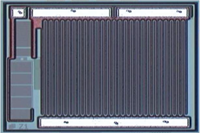Cross-referencing a bare die is not the same process as one would use for a package component, this is for two main reasons.
1) The mechanical considerations of the die are more complex than a packaged component.
Package Component:
- Conforms to standard dimensional footprint for a given family
- If multiple vendors make the part then package pin-outs are likely to be matched
- Assembly profile well known
Bare Die Component:
- Unique X-Y size
- Unique bond pad location
- Variable die thickness
- Wirebonding must comply with design-rules
- Die backside must be compatible in terms of mechanical attach+electrical potential
- May require a configuration of pads to be bonded, invisible to the package user.
2) Availability of a component in the bare die form is not the same as the packaged component.
Support for the bare die format varies greatly between semiconductor companies and even then this support will vary further by product family within that company. The reason for this is economic, as sales in the bare die format are a fraction (typically <1%) of total revenue. Due to that, the necessary engineering and internal investment to make bare die available doesn't happen.
At diedevices.com we have over 20 years experience using our knowledge and engineering resource to manage bare die availability.
Our cross-referencing process
Step 1 - Establish electrical requirement
The level of compatibility possible in a cross-reference depends on the component and also what's acceptable to the customer.
In general the component you want to cross-reference can be categorized into three sections:
- Bespoke/or combined functionality integrated on one die - No single chip alternative, solutions are limited to die re-engineering / reproduction of the die or changing the system design to use multiple components to achieve the same outcome.
- Has functional peers - Alternatives are available which are not a 100% match but could still be compatible for the application.
- Industry standard - Tend to be lower complexity components which are electrically a 100% match.
A typical circuit will use categories two and three, the majority of work done by diedevices.com relates to compatibility and availability. Category 3 tasks are largely concerned with identifying availability.
For category 2 tasks, it's much more efficient to understand from the customer what key parameters are strictly needed and which parameters have scope in terms of range or tolerance. This knowledge usually expands the choice of alternatives which would otherwise be limited if a direct analogue was required. However, when it's not possible to discuss key parameters, suggestions can be made by benchmarking the original datasheet.
Step 2 - Establish availability
Must meet commercial requirement of the customer.
- MOQ
- Unit Price
- Leadtime
- Current status and long term prognosis of availability
Step 3 - Establish mechanical requirement
- Refer against original substrate pad
- Refer against pad layout of original die
- Check new bondout meets max permitted wire length
Step 4 - Make proposal to customer.
- Provide low MOQ qtys for evaluation.
- Provide pad layout of recommend alternatives
When is cross-referencing unsuitable?
Where the bare die has a unique electrical function or where the approved design has no tolerance to changed parameters. In these cases either funding a dedicated production run of the original part (if possible) or designing a replacement bare die may be the only solution where a form fit and function replacement is needed. We can help with either option where required and work with many large semiconductor vendors and wafer foundries.


